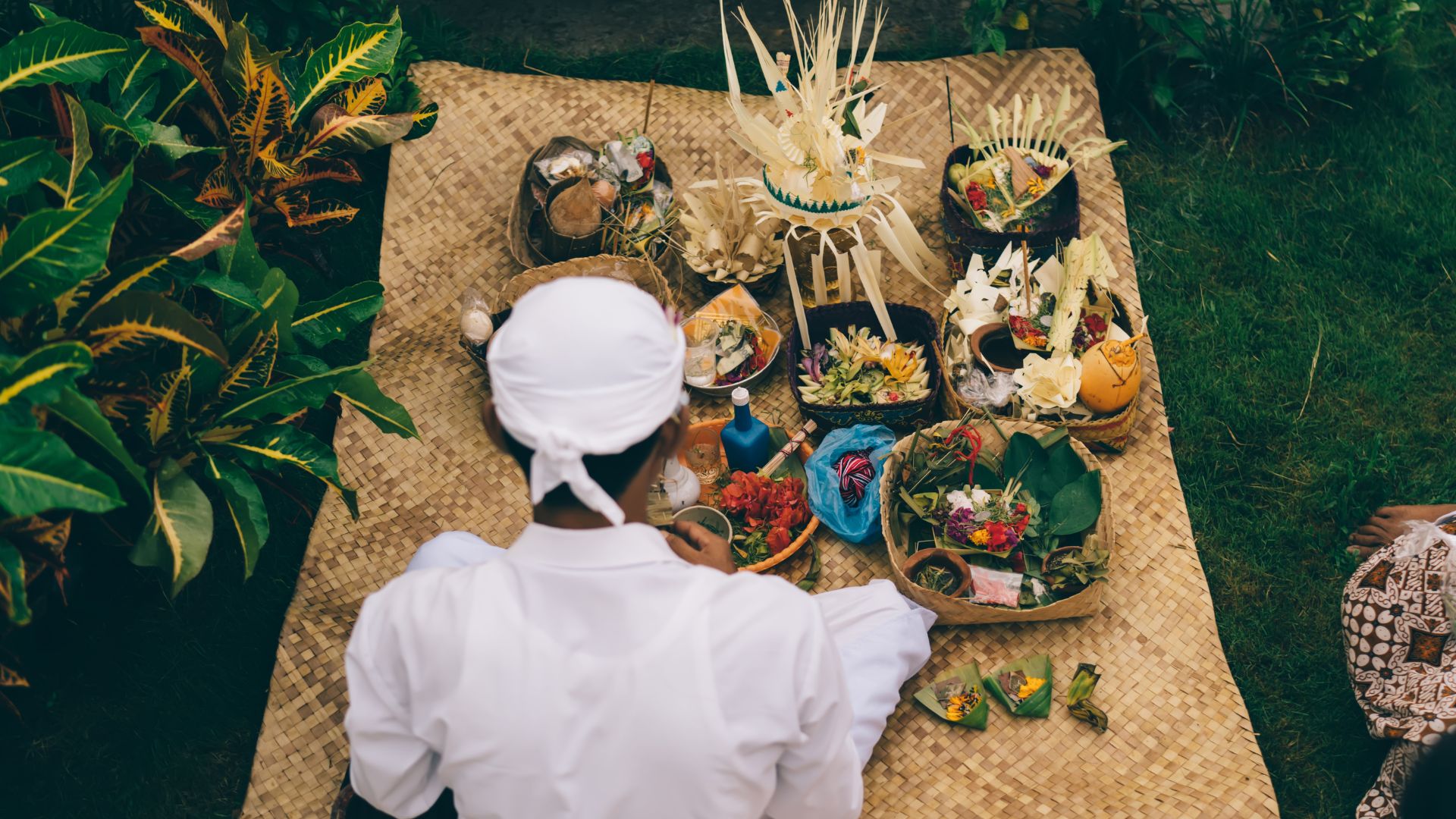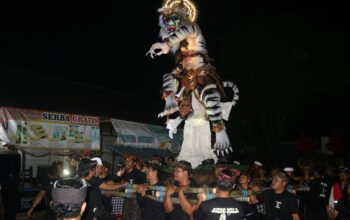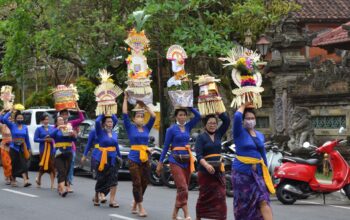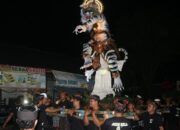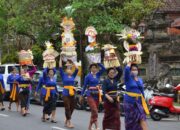General Questions about Otonan
What is the Otonan ceremony?
Otonan is a unique Balinese tradition performed to commemorate a person’s birthday, but it’s not like a regular birthday based on the Gregorian calendar. If you thought Otonan was like a birthday celebrated on the date on your ID card, that’s not quite right. In Bali, Otonan doesn’t use the Gregorian calendar (January, February, etc.) but uses the Balinese calendar system based on the Wuku. Otonan is celebrated every 210 days from a person’s birth date according to the Balinese calendar. So, even though your birthday comes once a year on a regular calendar, Otonan can happen twice a year! Because it uses the Wuku system, which has its own cycle, the Otonan date can change each year when viewed on the Gregorian calendar. Usually, families will record a baby’s birth date based on the day’s name (like Saniscara, Soma, etc.) and the Wuku’s name (for example, Kliwon, Pon, Wage, etc.). From there, the next Otonan will be calculated. Typically, the first Otonan is performed when the baby is about 6 months old (Balinese calendar), and then it continues regularly. This ceremony is considered an important moment for spiritual cleansing and strengthening the connection with the Creator.
Meaning and purpose of the Otonan ceremony in Bali
Otonan is not just an ordinary ritual – there’s a deep meaning behind it. This tradition is a form of gratitude for the life that has been given, as well as a time for self-introspection. In Balinese Hindu belief, humans are believed to carry karma from previous lives, and Otonan becomes a moment to purify oneself from bad karma. Additionally, Otonan is also believed to be a way to strengthen harmony between humans and the universe, fellow humans, and God. The main purpose is for the person undergoing Otonan to receive blessings of longevity, health, and safety in life.
Why is the Otonan ceremony important in Balinese culture?
In Bali, Otonan holds a special place in spiritual and cultural life. Balinese society believes that life is not just about the physical, but also about the balance between the physical and spiritual elements. Otonan is considered a way to maintain that balance. Besides being a form of respect for ancestors and God, Otonan also serves as a reminder that life is a journey full of lessons. By regularly performing Otonan, Balinese people are taught to always be self-aware, improve themselves, and not forget to be grateful for every blessing in life. Even as times become more modern and technology advances, the Otonan tradition remains preserved in Balinese society. Many young Balinese still faithfully perform this ceremony because they understand the importance of the spiritual values contained within it.
Implementation and Procession
Procession of the Otonan ceremony
The Otonan ceremony in Bali is usually performed simply but full of meaning. It doesn’t have to be lavish; what’s important is that it’s carried out with sincere intention and according to tradition. Usually, Otonan is performed at home, specifically in the house compound (sanggah or merajan), the family’s sacred place. The procession begins with a prayer or communal prayer, led by a pemangku (traditional priest) or by an elder family member. The child or person undergoing “otonan” will sit in front of the offerings and undergo a self-purification process, such as being sprinkled with holy water and having special prayers recited. Sometimes, small children will be carried or seated on a special mat during the ceremony. After the ceremony, it is usually followed by a family meal as a form of gratitude.
Equipment and means used in Otonan?
Although it appears simple, the Otonan ceremony still requires some special equipment. The most important, of course, are banten or sesajen (offerings). The type of banten used can vary depending on family customs, but usually include:
- Canang sari: small offerings containing flowers and janur (young coconut leaves)
- Tepung tawar: a symbol of purification and cleansing
- Small tumpeng or yellow rice: as a symbol of prosperity
- Holy water (tirta): used to sprinkle the person undergoing OtonanAdditionally, ayaban (special ceremonial food) and dupa (incense) are sometimes prepared as means of prayer. All this equipment is carefully arranged and prepared by family members, especially the mothers.
Who is involved in the Otonan ceremony?
Usually, Otonan is a family event, so those involved are mostly immediate family members. From parents, grandparents, siblings, to children, everyone participates. If there is a pemangku or traditional priest who is usually asked to lead prayers, they are also involved in the procession. The person undergoing Otonan is the main figure in this ceremony. But spiritually, this ceremony also brings goodness to all family members. That’s why many make Otonan a moment to gather, pray for each other, and strengthen family bonds.
Types and Variations
Is Otonan only for babies, or is it also performed by adults?
Many people think Otonan is only for babies—but in fact, Otonan applies to all ages, from newborns to the elderly. So, even if we are adults, we can (and should) still perform Otonan. Many Balinese people diligently celebrate their Otonan until old age as a form of respect for life and a hope for continued safety and longevity. Otonan is not just a children’s event, but part of a spiritual cycle that continues throughout life. So, there is no such thing as “too old for Otonan.”
Differences between the first Otonan (baby) and subsequent Otonan?
The first Otonan—performed when the baby is around 6 months old according to the Balinese calendar—usually has special treatment. Because this is the first Otonan, the ceremony tends to be more complete and sacred than subsequent Otonan. Usually, the first Otonan is prepared more elaborately. More equipment is used, it can involve more complete banten, and sometimes a pemangku is invited to lead the procession. This is done because the first Otonan is considered the beginning of the child’s spiritual life, so it needs to be specially purified and blessed. Meanwhile, subsequent Otonan, performed every 210 days, can be carried out more simply. The important thing is that there are still prayers, offerings, and a sincere intention to purify oneself and ask for safety. Some families may only use canang sari and tirta, but the meaning remains profound.
Symbolism and Philosophy
Philosophy behind the Otonan ceremony
Behind the seemingly simple Otonan ceremony, there is actually a deep meaning. This tradition is not just about commemorating a birthday, but also about reflecting on our life journey. Otonan reminds us that life is not just about the physical, but also about the spiritual. Through Otonan, Balinese people are taught to always introspect—to reflect on what has been done so far and to improve themselves in the future. This ceremony also symbolizes gratitude to God for being given life, health, and the opportunity to live better. In every Otonan, we are “reminded again” not to forget our origins as creations of God, and that life must be lived with full awareness, virtue, and balance.
Connection of Otonan with the concept of reincarnation or karma in Balinese Hinduism
In Balinese Hindu teachings, the concepts of reincarnation and karma are known—where every person is believed to be reborn as a result of deeds in previous lives. The Otonan ceremony is closely related to these two concepts. Otonan is performed as a way to cleanse the remnants of bad karma that may have been carried over from past lives. So, it can be said that Otonan is a kind of “self-purification ritual” so that we can live our current lives better and lighter spiritually. Furthermore, because life is a continuous process (it doesn’t end in one birth), Otonan serves as a reminder that we must continue to do good so that later, in the next life, we can be born in better conditions. Through Otonan, Balinese people not only carry out tradition but also strengthen their connection with nature, God, and fellow humans—thus making life more balanced and harmonious, in accordance with Balinese Hindu teachings.
Social and Cultural Aspects
How does Balinese society interpret Otonan in daily life?
For Balinese society, Otonan is not just a customary event or a hereditary tradition. More than that, Otonan is part of a spiritual lifestyle that is integrated into daily life. It’s not surprising that many Balinese families still cherish this tradition wholeheartedly, even amidst the busyness of modern times. Usually, Otonan becomes a moment of reflection—a good time to pause and ponder what we have done so far, and how we can become better individuals in the future. Additionally, this ceremony is also interpreted as a form of gratitude for the life, health, and happiness given by God. Otonan is also often used as a family gathering event. Although it’s a simple event, the atmosphere is warm and full of togetherness. So, socially, Otonan not only strengthens the relationship with the divine (God) but also with fellow family members and the surrounding community.
Is Otonan still frequently performed by the younger generation of Bali?
Although times are becoming more modern and the lifestyle of today’s youth has changed significantly, many young Balinese still maintain the Otonan tradition. Indeed, the way it is performed may be more practical or simple, but its core values are still highly upheld. In fact, many young Balinese are now aware of the importance of preserving their cultural identity. They continue to perform Otonan as part of their spiritual responsibility and pride in their ancestral heritage. Especially with the help of technology, such as digital Balinese calendars and automatic reminders, they can more easily know when their Otonan day arrives. It can be said that Otonan is not an outdated tradition, but rather a strong symbol that Balinese people have deep cultural roots, yet can still adapt to the modern world. And that’s what keeps this tradition alive today.
Conclusion
Otonan is a Balinese tradition celebrated every 210 days as a form of gratitude for life, self-purification, and a reminder to continue doing good. This ceremony applies to all ages and is performed simply but with profound spiritual meaning. More than just a ritual, Otonan reflects the Balinese philosophy of life—in harmony with nature, fellow humans, and God. Although times change, this tradition is still maintained by the community, including the younger generation, as a cultural heritage that strengthens identity and noble values of life.
